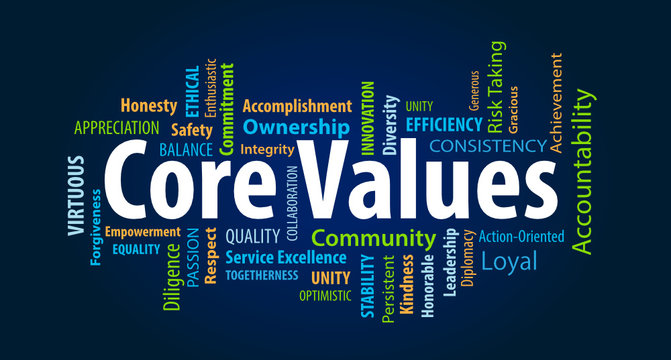What are company core values?
The term “value” can have different meanings. In our society we mostly connect it to the amount of money that can be received for something or how useful or important something is. However, if we look up the plural term “values” we find a more interesting meaning: “The beliefs people have, especially about what is right and wrong and what is most important in life, that control their behavior.” So values are something that gives us an idea about the right direction for our daily interactions. That makes this something useful (valuable), that you can also use to help define your team’s identity and purpose.
Making our core values visible helps to give us not only a better self-understanding, but also a better understanding of the actions we take. Keep in mind that making your values transparent is also a great tool for your company, your department or yourself. Each of these levels of purpose can have its own core values. Taking this one step further, we can also distinguish between core values and wish values. Core values are the virtues that are wired into our mindset or culture and lead to our natural behavior. They reflect “who you are”. This means, they are implied through and reflect our daily actions, but are not directly expressed by us. Beside the “who you are” it’s also interesting to discover “who you would become”. These values are called wish values and reflect our aspirational values which complement our core values.
As an example of values we can use the well known Scrum values:
- focus
- openness
- commitment
- courage
- respect
As a team member of a Scrum team we have to respect the values and commit ourselves to them. We commit to focusing on “What is important now?” and we commit ourselves to respect and not to waste the money of our sponsors and so on. If we ask ourselves: “Should I make our metrics immediately transparent for our management, even if they show us that our progress is too slow? Or should I wait for the next review?” then we can utilize the values of courage and openness to get us on the right track.

Of course there are more values. If we just browse the web or have a look at Jurgen Appelo’s Value Stories & Culture Books, we can find plenty of example of values. A word of caution – just be careful that your mind is not biased and narrowed down by an example list. Try to start with a very thorough list of values and see what emerges.
Why do transparent values help us?
Now, we have an idea of what values are, let’s better understand what they can be used for. What is the advantage of pinning them up on a wall so everybody can see them? What is the benefit of identifying the values that reflect our actions in the past? It’s not only about helping us to take the right decision. Here are further advantages of transparent values applicable to ourselves, our team, our department or our organization:
Characteristics of Company Core Values
- Reminding: A value can be a reminder of how to act in a given situation.
- Guiding: Values are like a compass and allow us to make decisions more easily within our current activity.
- Focusing: Values help us to keep the focus on what is important right now.
- Inspiring: A value can be an inspiring purpose for our whole company, department or team.
- Influencing: Clear values can influence our behavior at work and can be a force behind our motivation, commitment and productivity.
- Reflecting: Values are part of our identity. In the case of a company they are part of your culture. It’s how our customers recognize you.
- Clarifying: In a team or larger group context, the visualization of core values can invite discussion and reveal different points of view.
- Team building & trust building: Clarification of values for each individual can give us a better sense of and insight into our colleagues and therefore change the way we interact.
Once established, the fact that we stand as a team for our values is an especially important lever for every business. If you want to create a high quality product and sell it with your promise, you need to hold our value flag of “professionalism” or “focus on quality” up high, for your company, your department, your team. Your customers will recognize–or at least subconsciously perceive–if the values you are representing outwardly are also those you are reflecting in our actions and they will rate you accordingly. Wouldn’t it therefore be useful to know through your values who you are (core values) and who you would like to become (wish values)? That’s exactly the point where transparent values help you.
Team or Company Core Values Workshop
The question now is how can you determine common values for your own team? In our company, NovaTec Consulting GmbH, we were able to determine team values by applying the following steps. You can either dedicate a retrospective for this workshop, or separate the single steps into several workshops (or a combination). This depends on the maturity of the team. In our experience you should invest at least four hours for a single workshop.
Try this exercise with three to nine team members. But, keep in mind, with some small adaptations relating to the participants, preparation and timeboxes, it could also be your company, your department or simply yourself.
Considerations before starting your values workshop
There are no real “prerequisites,” only considerations. Depending on the maturity of your team you will end up with differing views on values. A team that has only worked together for two weeks will not be able to achieve the same qualitative values as a team that has worked together for more than a year. It’s all about trust, openness and common experiences. With a newly formed team, you should first focus on wish values, inspect these in a later retrospective and decide whether you have achieved these values. If so then these can be accepted as your first core values.

Preparing your team
Probably the most important factor is to help your team understand just what are core values versus wish values, and what’s the advantage of visualizing them. Share common expectations for your workshop. With the “Why” section above you should have plenty of arguments. As mentioned earlier, you should be careful when giving your team a list of values as examples. In our experience, this narrows down the team to only focus on the values on the list and not think more broadly. It is better to explain what are values and the benefits of them interactively and let two or three values be discovered through the conversation. You may also want to discuss exemplary daily situations and agree on some values based on these situations. Values can be creative. Freedom and honor are great examples, but it could also be something like “We never walk alone” which implies teamwork, collaboration and helpfulness making the value much more powerful.
When everyone has a common understanding of values, we are ready for the next step.
Collecting and sharing value stories
It’s now time to collect stories. In the best case scenario, we would have given our team homework to collect stories which reflect current behavior.
These stories can be delivered in images, videos, text or whatever medium our team members prefer. As mentioned, the only requirement is, that everyone can tell a story about through a visualization which is meaningful for ourselves and our team.
If we know our team members do not have the time for “homework,” we use a longer timebox to collect stories on the fly (15-30 minutes). We then ask every team member to recall the most valuable or remarkable events they’ve experienced with the team. They should think about at least one event that reflects a good behaviour and one event that reflects a behaviour which affected the team in a negative way. Depending on your timebox let everybody write down (or draw) one to three positive and one to three negative stories. Keep the written/drawn part short and use small cards. As described in the next step, the individual team members should tell their story to intensify nonverbal communication and not just read their examples out loud.
Now it’s time to let our team members tell their story in front of the whole team. Before the first one starts, give the others some sticky notes. As everyone is telling his or her own story, let the others write down the team value or values they see emerging in this story. They can write down either a core value or a wish value that reflects the situation. No discussion is allowed, only comprehension questions relating to the story can be posed. A good practice is to add a reference number or the name of the owner on the story card/value notes for later discussion.
Rank your own values
You may have heard of Moving Motivators. It’s a card game from Management 3.0 to rank your own business related motivators. In our scenario, we reuse the ranking mechanism. Let everybody place their own value notes in two horizontal lines on a wall – one line for the core values and one line for the wish values. Let everyone rank their own values from left to the right (e.g. left = less important, right = more important).
Cluster and vote
Now let everyone briefly share their most important values, up to three of each for core values or wish values. After introducing a value, begin clustering on a board via discussion within the team. When all values are clustered provide everyone sticky dots for voting. If each person introduced three core and three wish values, you could allow them to use three voting dots. Alternatively you can determine the number of votes per person by halving the number of clusters produced in the earlier sorting.
Choose and commit to your values
Through the clustering and voting we have now democratically chosen our team values. As a team we can decide on how many values to pick and to visualize. However, keep in mind, that focus is a value we should respect.
Keeping focus on only a few things at a time, helps us to maximise our valuable output for our customers and ourselves. Therefore we should try to agree on three up to a maximum of five values in each category (up to five core and five wish values).
Inspect and adapt
To make the time worthwhile we have to live our core values and get closer to achieving our wish values, day in, day out. The most important thing here is reflection. Our values may change as our team grows or reaches a new maturity level. Wish values may become core values, or starting core values may become obsolete. Use your retrospective to ask yourself and your team if you can still commit to your current statement of values. Do they reflect your daily decisions and how you go about your work? Can I make decisions based on these values with a clear conscience? Do we still stand behind these values together as a team? Are our values still compatible with those of our department, our company and our management? For the last question it can help to carry out this workshop on different levels of purpose and compare the results.
Before you end your value workshop you may also want to appoint a “Keeper of values,” a team member who is responsible for making situations transparent and questioning if any actions do not fully reflect the agreed team values.












Replies to This Discussion